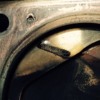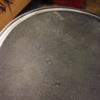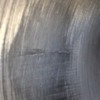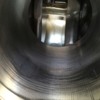And the piston, with a clear imprint of the stud...
No sign that the valve or stud made contact with the cylinder wall. I was idling at a red light when this happened, and it looks like the stud just started to started to go in, got stuck in the valve, and then got slammed against the head which stopped the engine suddenly from idle (approx 600-650 RPM). And that's why the engine wouldn't turn over or even budge the slightest when I tried to restart - the stud was jammed between the piston and the squish area of the head which wouldn't allow the piston to reach TDC.
The valve definitely looks bent. I'm going to measure for any rod bend tonight, then take the head to my machine shop in a day or so. I'm hoping I can get away with a little clean up on the head and piston, and a new valve. Fingers crossed!
The valve definitely looks bent. I'm going to measure for any rod bend tonight, then take the head to my machine shop in a day or so. I'm hoping I can get away with a little clean up on the head and piston, and a new valve. Fingers crossed!
crossed mine also, hope it helps
but thinking on the darker side, besides observing deck height to look for bent rod, do you think you would be able to tell if the bearing got damaged?
but thinking on the darker side, besides observing deck height to look for bent rod, do you think you would be able to tell if the bearing got damaged?
quote:do you think you would be able to tell if the bearing got damaged?
I'll ask my machine shop about that. I honestly don't know how I would check it, other than removing the pan to split the rod and cap and mic the thickness of each half of the bearing.
The most delicate part of the piston is the top ring land because of the deep cut-away for the ring. They normally crack from even light impacts so I'd suggest pulling that rod to check the piston and then you'll also be able to check the bearing. I doubt if the rod, bearing or crank were affected if the engine stopped instantly.
quote:The most delicate part of the piston is the top ring land because of the deep cut-away for the ring. They normally crack from even light impacts so I'd suggest pulling that rod to check the piston
Yeah, I'm concerned about that too. Going to pull the piston as well to inspect.
quote:Originally posted by garth66:quote:I welded the wing nut to the stud where it exits the top of the air cleaner. If the stud ever loosens up, it just spins and can never fall in the carb.
Brilliant idea! This afternoon I was trying to think of how I could secure the air cleaner to the carb without risk of the stud (or a jamb nut) falling into the carb. Your solution is so much simpler (and better) than the things I was thinking of. I will definitely do that in the future!
Garth first hoping that your repairs are minimal in work and cost.
Not wanting to hijack your thread. But this brings up a concern for me and anyone running non OEM intake/carb. The Edelbrock manifold combined with a Demon carb and the ever popular Hall air cleaner is secured by a Hall billet knob.
The air cleaner top rests under the back edge of the OEM screen with a slight bow to the screen rear frame. The securing knob also just barley touches the screen. Their is contact to both and I am now concerned with the stud fatiguing and eventually failing as yours did.
I like the convenience of a stud over a bolt and am concerned about the threads in side the carb fatiguing over time with numerous R&R.
My thought is making a stud from a grade 8 bolt secured with a grade 8 nut. The grade 8 should be difficult/impossible to break even with some constant load ?
Anyone else have a solution ?
"Now nervous" Jeff
Jeff,
If you have a Demon carb, they use a 5/16" stud. Much less likely to fatigue and fail than the 1/4" stud used by Holley and most of the others. Better: Ditch the stud and use a bolt.
Best: Take off your manifold and have a machinist mill the carb pad flat and as low as he dares. The Edelbrock is very receptive to this because the runners were designed for a level carb pad. Take a look at a Blue Thunder and you'll see what I mean.
Have the machinist remove the carb studs and re-drill the stud holes square to the new carb pad surface and helicoil them.
Find an insulating carb spacer that is: a. thin enough to ensure no contact between the air cleaner housing and your engine cover, and b. thick enough to ensure the butterfly linkages don't hit the manifold anywhere between idle and WOT.
Regarding that Hall air cleaner lid: I had my machinist mill a lip around the circumference. It dropped the lid a wee bit and it doesn't look so "thick" sitting on the air cleaner element. I do have to work the element a bit to squeeze it in as the diameter inside the lip is just about 13 13/16" vs the 14" element.
If you have a Demon carb, they use a 5/16" stud. Much less likely to fatigue and fail than the 1/4" stud used by Holley and most of the others. Better: Ditch the stud and use a bolt.
Best: Take off your manifold and have a machinist mill the carb pad flat and as low as he dares. The Edelbrock is very receptive to this because the runners were designed for a level carb pad. Take a look at a Blue Thunder and you'll see what I mean.
Have the machinist remove the carb studs and re-drill the stud holes square to the new carb pad surface and helicoil them.
Find an insulating carb spacer that is: a. thin enough to ensure no contact between the air cleaner housing and your engine cover, and b. thick enough to ensure the butterfly linkages don't hit the manifold anywhere between idle and WOT.
Regarding that Hall air cleaner lid: I had my machinist mill a lip around the circumference. It dropped the lid a wee bit and it doesn't look so "thick" sitting on the air cleaner element. I do have to work the element a bit to squeeze it in as the diameter inside the lip is just about 13 13/16" vs the 14" element.
Attachments
quote:Originally posted by larryw:
Jeff,
If you have a Demon carb, they use a 5/16" stud. Much less likely to fatigue and fail than the 1/4" stud used by Holley and most of the others. Better: Ditch the stud and use a bolt.
Best: Take off your manifold and have a machinist mill the carb pad flat and as low as he dares. The Edelbrock is very receptive to this because the runners were designed for a level carb pad. Take a look at a Blue Thunder and you'll see what I mean.
Have the machinist remove the carb studs and re-drill the stud holes square to the new carb pad surface and helicoil them.
Find an insulating carb spacer that is: a. thin enough to ensure no contact between the air cleaner housing and your engine cover, and b. thick enough to ensure the butterfly linkages don't hit the manifold anywhere between idle and WOT.
Regarding that Hall air cleaner lid: I had my machinist mill a lip around the circumference. It dropped the lid a wee bit and it doesn't look so "thick" sitting on the air cleaner element. I do have to work the element a bit to squeeze it in as the diameter inside the lip is just about 13 13/16" vs the 14" element.
Larry,
Thanks for all of the good suggestions. And I like what your machinist did to the Hall top. I agree it is bit thick.
I think I found a great solution to the weak carb air cleaner studs typical in the aftermarket. ARP makes air cleaner studs that are rated at the equivalent of grade 8 bolts.
I have always liked the quality of ARP products and if the equivalent of a grade 8 bolt there should be no chance of failure.
Jeff
Latest update...
Well, the prognosis only gets worse... I pulled the #8 piston Sunday and found what looked like 2 scratches in the cylinder wall, which assumed to be from bits of the air cleaner stud scratching it in a couple places while the piston rode up and down. I gave it a light hone to see if they would clean up, then examined them more closely; one of them is definitely not a scratch! It's clearly a crack, located at about 7 o'clock as you look down the cylinder. It's an inch or so from the top and extends to about half way down the bore, maybe a little below, near where the bottom of the piston would. My thought is that when the piston hit the bolt at the top of the cylinder and caused the engine to stop suddenly, the extreme force at the very top edge of the piston may have caused the piston to rock in the bore and crack the block, as this spot pretty closely aligns with the bottom edge/point of the piston skirt, right where it comes back up toward the pin. That's all that I can figure. You'll notice in the picture that there are matching depressions in the cylinder wall at 4 o'clock and 7 o'clock which is where the bottom edges of the piston skirt would have pushed on the cylinder wall. When I ran the hone in the bore, these spots weren't even touched by the hone, which means the cylinder wall is pushed out in those two spots.
FWIW, I did measure the bearing in multiple spots and didn't find detectable bearing crush from the impact. Top and bottom half bearing measurements were very consistent with one anther, with only about ~1 thousandth's difference between side and center measurements.
Another engine pulling party to be scheduled soon. Stay tuned!
Well, the prognosis only gets worse... I pulled the #8 piston Sunday and found what looked like 2 scratches in the cylinder wall, which assumed to be from bits of the air cleaner stud scratching it in a couple places while the piston rode up and down. I gave it a light hone to see if they would clean up, then examined them more closely; one of them is definitely not a scratch! It's clearly a crack, located at about 7 o'clock as you look down the cylinder. It's an inch or so from the top and extends to about half way down the bore, maybe a little below, near where the bottom of the piston would. My thought is that when the piston hit the bolt at the top of the cylinder and caused the engine to stop suddenly, the extreme force at the very top edge of the piston may have caused the piston to rock in the bore and crack the block, as this spot pretty closely aligns with the bottom edge/point of the piston skirt, right where it comes back up toward the pin. That's all that I can figure. You'll notice in the picture that there are matching depressions in the cylinder wall at 4 o'clock and 7 o'clock which is where the bottom edges of the piston skirt would have pushed on the cylinder wall. When I ran the hone in the bore, these spots weren't even touched by the hone, which means the cylinder wall is pushed out in those two spots.
quote:do you think you would be able to tell if the bearing got damaged?
FWIW, I did measure the bearing in multiple spots and didn't find detectable bearing crush from the impact. Top and bottom half bearing measurements were very consistent with one anther, with only about ~1 thousandth's difference between side and center measurements.
Another engine pulling party to be scheduled soon. Stay tuned!
Attachments
And I now have an ARP air cleaner stud, which will be spot welded to the air cleaner wingnut.
Here's a pic looking down the cylinder. You can see the corresponding dark spots where the hone didn't touch the cylinder walls. Note that the left patch isn't as dark because I got in there with some 800 grit sandpaper to clean the spot a bit more when I first thought it was a scratch. Again, these line up with the bottom edges of the piston skirt.
Here's a pic looking down the cylinder. You can see the corresponding dark spots where the hone didn't touch the cylinder walls. Note that the left patch isn't as dark because I got in there with some 800 grit sandpaper to clean the spot a bit more when I first thought it was a scratch. Again, these line up with the bottom edges of the piston skirt.
Attachments
Garth -
That really blows. Good luck with the rework.
Rocky
That really blows. Good luck with the rework.
Rocky
Maybe the cylinder can be sleeved? It worked well on the rust spots on two of my cyliders
Sorry to hear this latest bit of news Garth. Was hoping for better luck for the Bonzai.
Dennis
Dennis
quote:Maybe the cylinder can be sleeved? It worked well on the rust spots on two of my cyliders
That's the plan... Pulled the engine on Sunday and dropped in a fresh 351C that was slated to go into the Mach 1. That car is just a shell on wheels at the moment, so I decided to "break it in" in the Pantera while I rebuild the Pantera's engine, AGAIN.
Trivia fact on the Mach 1 engine... It was originally out of a Pantera, so somewhat appropriate that it's going into a Pantera, at least for a short while.
I am glad you were able to work out a plan.
Better get going on the build - remember:
"....Speed is the only thing that counts!"
(I couldn't help it!)
Rocky
Better get going on the build - remember:
"....Speed is the only thing that counts!"
(I couldn't help it!)
Rocky
quote:Better get going on the build - remember:
"....Speed is the only thing that counts!"
Add Reply
Sign In To Reply





